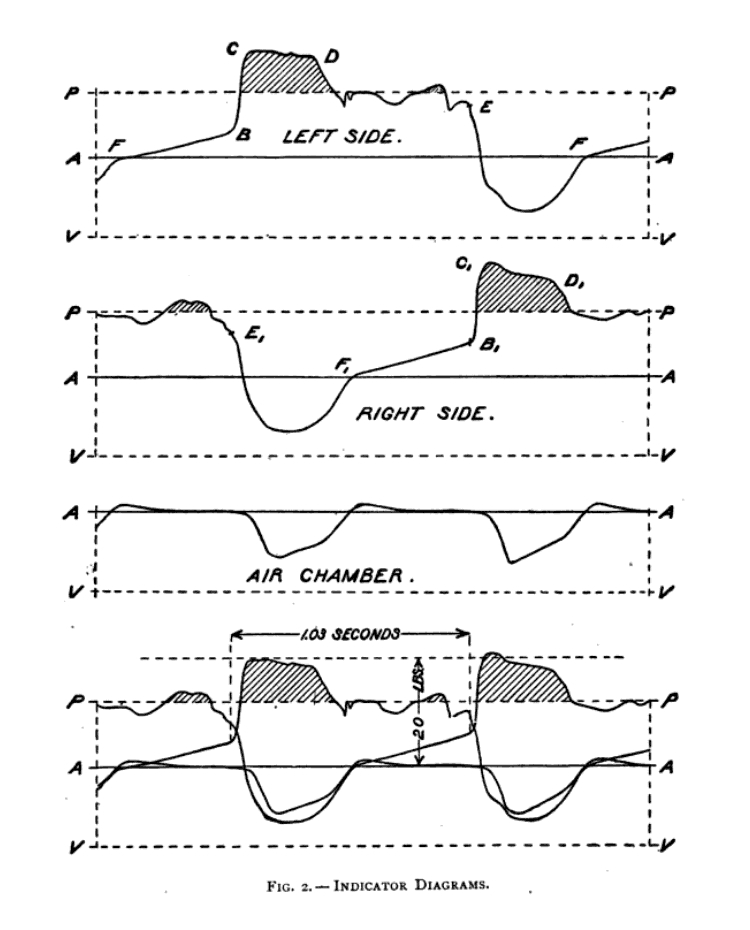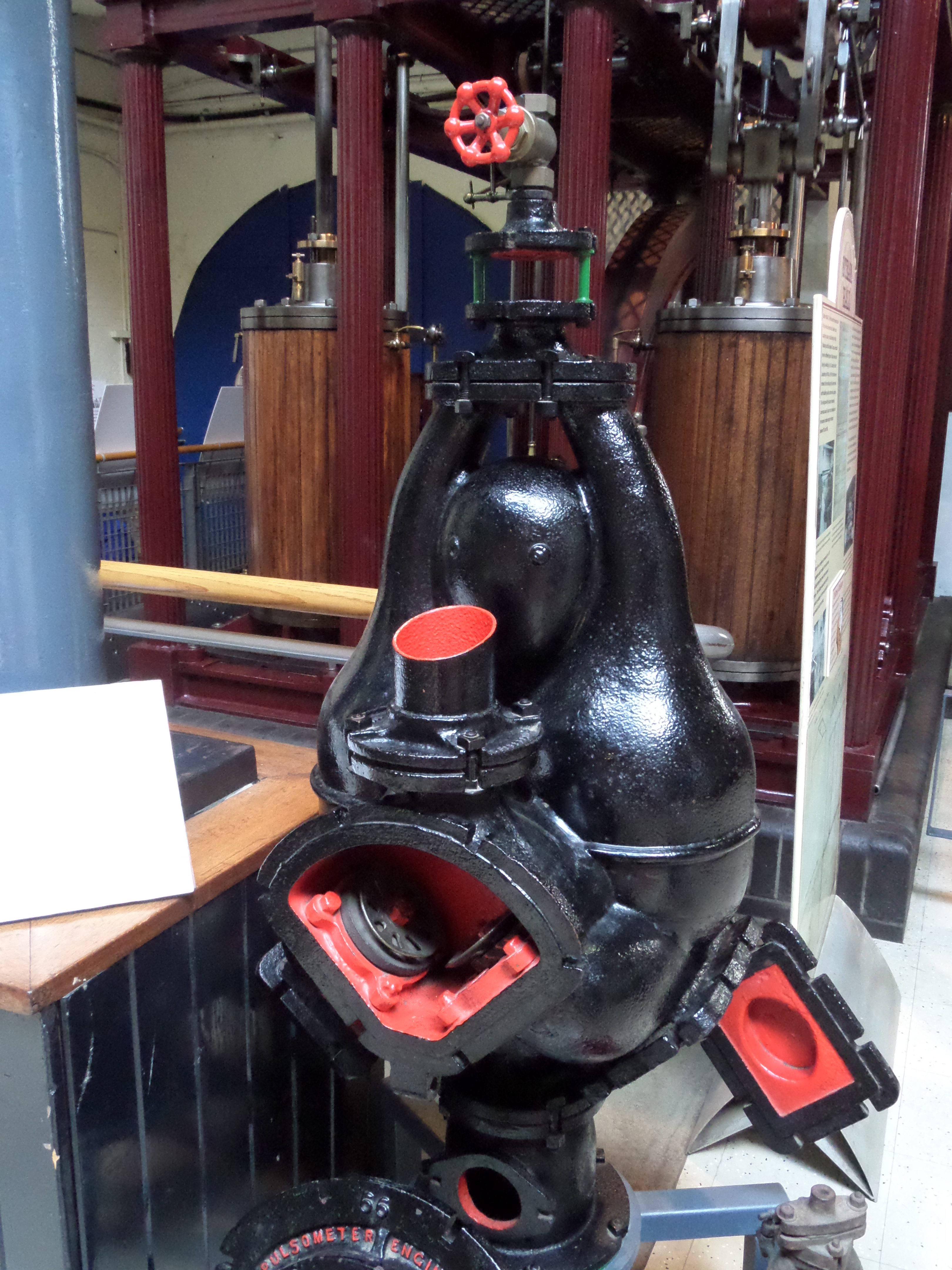Pulsometer steam pump on:
[Wikipedia]
[Google]
[Amazon]


 The Pulsometer steam pump is a
The Pulsometer steam pump is a
Kirloskar Brothers Limited
Pumps Steam power


pistonless pump
A pistonless pump is a type of pump designed to move fluids without any moving parts other than three chamber valves.
The pump contains a chamber which has a valved inlet from the fluid to be pumped, a valved outlet – both of these at the botto ...
which was patented in 1872 by American Charles Henry Hall. In 1875 a British engineer bought the patent rights of the Pulsometer and it was introduced to the market soon thereafter. The invention was inspired by the Savery steam pump
A pump is a device that moves fluids (liquids or gases), or sometimes slurries, by mechanical action, typically converted from electrical energy into hydraulic energy. Pumps can be classified into three major groups according to the method they ...
invented by Thomas Savery
Thomas Savery (; c. 1650 – 15 May 1715) was an English inventor and engineer. He invented the first commercially used steam-powered device, a steam pump which is often referred to as the "Savery engine". Savery's steam pump was a revolutionar ...
. Around the turn of the century, it was a popular and effective pump for quarry
A quarry is a type of open-pit mining, open-pit mine in which dimension stone, rock (geology), rock, construction aggregate, riprap, sand, gravel, or slate is excavated from the ground. The operation of quarries is regulated in some juri ...
pumping.
Construction and operation
This extremely simple pump was made ofcast iron
Cast iron is a class of iron– carbon alloys with a carbon content more than 2%. Its usefulness derives from its relatively low melting temperature. The alloy constituents affect its color when fractured: white cast iron has carbide impu ...
, and had no piston
A piston is a component of reciprocating engines, reciprocating pumps, gas compressors, hydraulic cylinders and pneumatic cylinders, among other similar mechanisms. It is the moving component that is contained by a cylinder and is made gas- ...
s, rods, cylinders
A cylinder (from ) has traditionally been a three-dimensional solid, one of the most basic of curvilinear geometric shapes. In elementary geometry, it is considered a prism with a circle as its base.
A cylinder may also be defined as an infini ...
, cranks, or flywheel
A flywheel is a mechanical device which uses the conservation of angular momentum to store rotational energy; a form of kinetic energy proportional to the product of its moment of inertia and the square of its rotational speed. In particular, assu ...
s. It operated by the direct action of steam
Steam is a substance containing water in the gas phase, and sometimes also an aerosol of liquid water droplets, or air. This may occur due to evaporation or due to boiling, where heat is applied until water reaches the enthalpy of vaporizat ...
on water
Water (chemical formula ) is an inorganic, transparent, tasteless, odorless, and nearly colorless chemical substance, which is the main constituent of Earth's hydrosphere and the fluids of all known living organisms (in which it acts as ...
. The mechanism consisted of two chambers. As the steam condensed in one chamber, it acted as a suction
Suction is the colloquial term to describe the air pressure differential between areas.
Removing air from a space results in a pressure differential. Suction pressure is therefore limited by external air pressure. Even a perfect vacuum cannot ...
pump, while in the other chamber, steam was introduced under pressure and so it acted as a force pump. At the end of every stroke, a ball valve
A ball valve is a flow control device which uses a hollow, perforated and pivoting ball to control fluid flowing through it. It is open when the ball's hole is in line with the flow inlet and closed when it is pivoted 90-degrees by the valve ...
consisting of a small brass
Brass is an alloy of copper (Cu) and zinc (Zn), in proportions which can be varied to achieve different mechanical, electrical, and chemical properties. It is a substitutional alloy: atoms of the two constituents may replace each other wit ...
ball moved slightly, causing the two chambers to swap functions from suction-pump to force-pump and vice versa. The result was that the water was first suction pumped and then force pumped.
A good explanation can be found in the 1901 article referenced below: The operation of the pulsometer is as follows: The ball being at the entrance of the left-hand chamber, and the right-hand being full of water, steam enters, pressing on the surface of the water, and forcing it out through the discharge passage. A rapid condensation of steam occurs from contact with the water and with the walls of the chamber, previously cooled by the water. When the water level has reached the horizontal edge of the discharge passage, a large volume of steam suddenly escapes and is at once condensed by the relatively cold water between the chamber and the discharge valve. The pressure in the chamber quickly decreases; it cannot be sustained by steam from the boiler, for, in accordance with the inventor's first specifications, the steam pipe is small. If now the pressure in the left chamber is equal, or nearly equal, to that in the right, friction caused by the rapid flow of steam past the ball will draw the ball over and close the right-hand chamber. Cut off from further supply, the steam, in contact with water, begins to condense; a jet of cold water from the discharge pipe spurts up through the injection tube, and by breaking into spray against the side of the steam space, completes the condensation. The partial vacuum produced brings water through the suction valve to fill the chamber; but at the same time the air valve admits a little air, which passes up ahead of the water and forms an elastic cushion to prevent the water from striking violently against the steam ball. The air chamber is for the purpose of preventing water-hammer in the suction pipe.
Advantages
The pump ran automatically without attendance. It was praised for its "extreme simplicity of construction, operation, compact form, high efficiency, economy, durability, and adaptability". Later designs were improved upon to enhance efficiency and to make the machine more accessible for inspection and repairs, thus reducing maintenance costs.Detailed analysis
In the January 1901 issue of ''Technology Quarterly and Proceedings of the Society of Arts'', an article appeared by Joseph C. Riley describing key operational details and technical evaluation of the pulsometer pump's performance. Riley noted that although somewhat inefficient, the pulsometer's simplicity and robust construction made it well suited to pumping "thick liquids or semi-fluids, such as heavy syrups, or even liquid mud".Pulsometer Engineering Company Limited
Pulsometer Engineering Company Limited was founded in Britain in 1875 after a British engineer bought the patent rights of the pulsometer pump from Thomas Hall. In 1901 the company moved fromLondon
London is the capital and List of urban areas in the United Kingdom, largest city of England and the United Kingdom, with a population of just under 9 million. It stands on the River Thames in south-east England at the head of a estuary dow ...
to Reading, Berkshire
Reading ( ) is a town and borough in Berkshire, southeast England. Located in the Thames Valley at the confluence of the rivers Thames and Kennet, the Great Western Main Line railway and the M4 motorway serve the town. Reading is east o ...
. In 1961 Pulsometer merged with Sigmund Pumps of Gateshead to form Sigmund Pulsometer Pumps. SPP Pumps Ltd became one of the largest pump companies in Europe. SPP Pumps Ltd is now part of Kirloskar Brothers Ltd.
References
{{reflistKirloskar Brothers Limited
Pumps Steam power